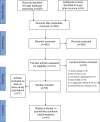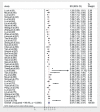Increasing prevalence of cerebral palsy among children and adolescents in China 1988-2020: A systematic review and meta-analysis
- PMID: 33961057
- PMCID: PMC8814846
- DOI: 10.2340/16501977-2841
Increasing prevalence of cerebral palsy among children and adolescents in China 1988-2020: A systematic review and meta-analysis
Abstract
Objectives: To investigate the pooled prevalence of cerebral palsy in China, analyse the differences between different subgroups, and explore the trend over the 32-year period from 1988 to 2020.
Methods: All potential studies related to the prevalence of cerebral palsy among children and adolescents in China were identified from 3 English-language databases and 4 Chinese-language databases. Pooled prevalence was calculated to estimate the prevalence of cerebral palsy among 0-18 years old and different geographical regions in China, using a random-effects meta-analysis model. Continuous fractional polynomial regression modelling was used to estimate the trend in prevalence of cerebral palsy over time. Subgroup analysis and meta-regression were conducted to investigate heterogeneity. Funnel plots and Egger's test were used to explore potential publication bias.
Results: The pooled prevalence of cerebral palsy over the study period among 0-18 years old and different geographical regions in China was 2.07‰ (95% confidence interval (95% CI) 1.66-2.47‰), and the prevalence of cerebral palsy was higher in males compared with females (2.25‰ vs 1.59‰), and in rural residents compared with urban residents (2.75‰ vs 1.90‰), respectively. The prevalence of cerebral palsy varied significantly between different geographical regions. In subjects with birthweights < 2.5 and > 4 kg, the prevalence of cerebral palsy was significantly higher than in subjects with birthweights between 2.5 and 4 kg. The trend in pooled prevalence of cerebral palsy increased continuously over the period studied, and could be divided into 3 stages; the mean annual increase in prevalence from 1988 to 1996 and from 2008 to 2019 was more rapid. Multivariate meta-regression found that the year of study was one of the sources of heterogeneity among overall prevalence. (p-value = 0.006).
Conclusion: The pooled prevalence of cerebral palsy over the 32-year period from 1988 to 2020 was 2.07‰. There was an increasing trend in prevalence of cerebral palsy among children and adolescents in China over this period.
Keywords: China; cerebral palsy; children; meta-analysis; prevalence.
Conflict of interest statement
Figures






References
-
- van Lieshout P, Candundo H, Martino R, Shin S, Barakat-Haddad C. Onset factors in cerebral palsy: a systematic review. Neurotoxicology 2017; 61: 47–53. - PubMed
-
- Wichers M, Hilberink S, Roebroeck ME, van Nieuwenhuizen O, Stam HJ. Motor impairments and activity limitations in children with spatic cerebral palsy: a Dutch population-based study. J Rehabil Med 2009; 41: 367–374. - PubMed
-
- van Eck M, Dallmeijer AJ, van Lith IS, Voorman JM, Becher JG. Manual ability and its relationship with daily activities in adolescents with cerebral palsy. J Rehabil Med 2010; 42: 493–498. - PubMed
-
- Hollung SJ, Vik T, Lydersen S, Bakken IJ. Decreasing prevalence and severity of cerebral palsy in Norway among children born 1999 to 2010 concomitant with improvements in perinatal health. Eur J Paediatr Neurol 2018; 22: 1–8. - PubMed
-
- Petersen TG, Forthun I, Lange T, Villadsen SF, Nybo Andersen AM, Uldall P, et al. . Cerebral palsy among children of immigrants in Denmark and the role of socioeconomic status. Eur J Paediatr Neurol 2019; 233: 507–516. - PubMed
Publication types
MeSH terms
LinkOut - more resources
Full Text Sources
Other Literature Sources
Medical

